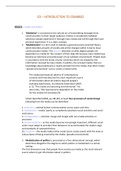Summary
Summary PARTIAL 2 Introduction to Communication Science (ICS) notes
- Course
- Institution
- Book
Everything is well organized and all the theories are explained in a clear way, easy to memorize IT ONLY COVERS FROM WEEK 8 ONWARDS. GOOD FOR PARTIAL 2 EXAM
[Show more]




